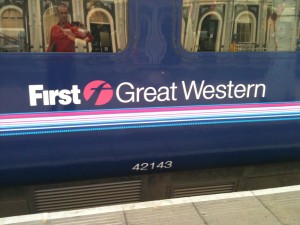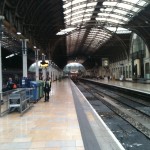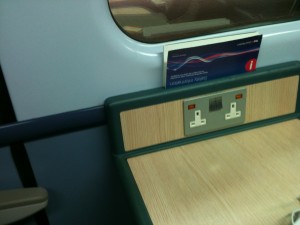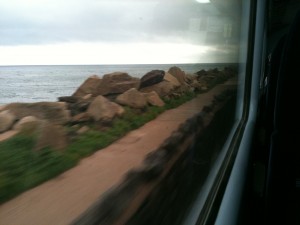 Torquay is the home of Basil Fawlty, the long suffering proprietor in the cringingly hilarious English Tv series Fawlty Towers. Its also the town in England where my ancestors came from.
Torquay is the home of Basil Fawlty, the long suffering proprietor in the cringingly hilarious English Tv series Fawlty Towers. Its also the town in England where my ancestors came from.
My grandfather often talked about the mighty Great Western Railway steam engines that connected the town to London. The railway designed by British engineer Isambard Kingdom Brunel, was designed to be fast, and stylish way of travel. Today the GWR is known as First Great Western (owned by First Group). They operate trains through to Wales and the southwest of England from London’s Paddington station (more well known for the adventures of a certain lost bear than its amazing engineering!)
Booking
The first thing one needs to be aware of is the bewildering number of fares that the Rail companies offer for the same seat. Rock up to the ticket office on the day and you will find a First Anytime single ticket will cost £169.50! (around $260-$270). I refuse to pay full fare and booked in advance, getting a non changeable, non refundable ticket for £14.50. I generally use three websites to buy train tickets in England:
- www.thetrainline.com/
- http://www.virgintrains.co.uk/
- http://www.southwesttrains.co.uk/
 Ticket Collection
Ticket Collection
I elected to collect my pre paid tickets from the automatic ticket machines at Paddington Station. I was very frustrated to find my Australian credit cards no longer work in the railway booking machines. This seems to be an ongoing trend. I cannot use them on some US subway systems because they ask for a five digit zip code. The First Great Westerbn ticket clerk was very helpful and printed off all my tickets for all of my UK train trips. There is no check in required for UK Trains.
Boarding
The Platform (Track) number was announced about 15 minutes before the departure time. Every carriage is clearly labelled by letter (I was in Car D). There are two doors to enter each carriage. Each door has a placard indicating which seats are located nearest that door. Once inside the carriage, seats are easily found. They are all clearly labelled with their numbers. On the headrest of each carriage is a small ticket sized card listing when the seat has been reserved. I had mine the whole way. The seat opposite me had four different occupants over the trip. Don’t expect to talk. English travellers are very adept at avoiding eye contact and conversation with strangers.
is clearly labelled by letter (I was in Car D). There are two doors to enter each carriage. Each door has a placard indicating which seats are located nearest that door. Once inside the carriage, seats are easily found. They are all clearly labelled with their numbers. On the headrest of each carriage is a small ticket sized card listing when the seat has been reserved. I had mine the whole way. The seat opposite me had four different occupants over the trip. Don’t expect to talk. English travellers are very adept at avoiding eye contact and conversation with strangers.
Seat pitch (distance between seats) in the Standard Class HST (High Speed Train) is 32″. The trains themselves are about 40 years old but have been extensively renovated. Luggage space compared to Australian and US trains is very limited. Travelling with a full size suitcase is best avoided. My carry on airline bag fits fine.
Route
 Exeter to Teignmouth-Newton Abbot, known as the “Riveria Line”, opened on 30th May 1846 (which makes it 165 years old) is my favourite part of the route. I was very pleased I had a window seat on the left side of the train. The rail line runs along the river Exe to the point where it meets the sea. The train runs along the seafront next to part of the The South West Coast Path is the longest walking trail in the United Kingdom. At this point, trains often get lashed by waves! The line was originally operated without engines being pushed instead by air pressure within a pneumatic tube laid between the rails. The system lasted for only a year. Not one of Brunel’s successes.There are several tunnels on the line which are a Brunel success. One tunnel is cut through an old smugglers’ tunnel.
Exeter to Teignmouth-Newton Abbot, known as the “Riveria Line”, opened on 30th May 1846 (which makes it 165 years old) is my favourite part of the route. I was very pleased I had a window seat on the left side of the train. The rail line runs along the river Exe to the point where it meets the sea. The train runs along the seafront next to part of the The South West Coast Path is the longest walking trail in the United Kingdom. At this point, trains often get lashed by waves! The line was originally operated without engines being pushed instead by air pressure within a pneumatic tube laid between the rails. The system lasted for only a year. Not one of Brunel’s successes.There are several tunnels on the line which are a Brunel success. One tunnel is cut through an old smugglers’ tunnel.
My ratings:
90% (4.5 out of 5)
Positives: Great views, on time, well organised
Negatives: Ticket machine not accepting Australian credit cards, limited luggage space,
Would I use them again? Yes, especially if I get a window seat on the side with a view of the sea


Congrats on your new blog host. Wanted to comment on the old one several times, but always got error messages.
Love your stuff and this train story is interesting as well!
Thank you twice over!